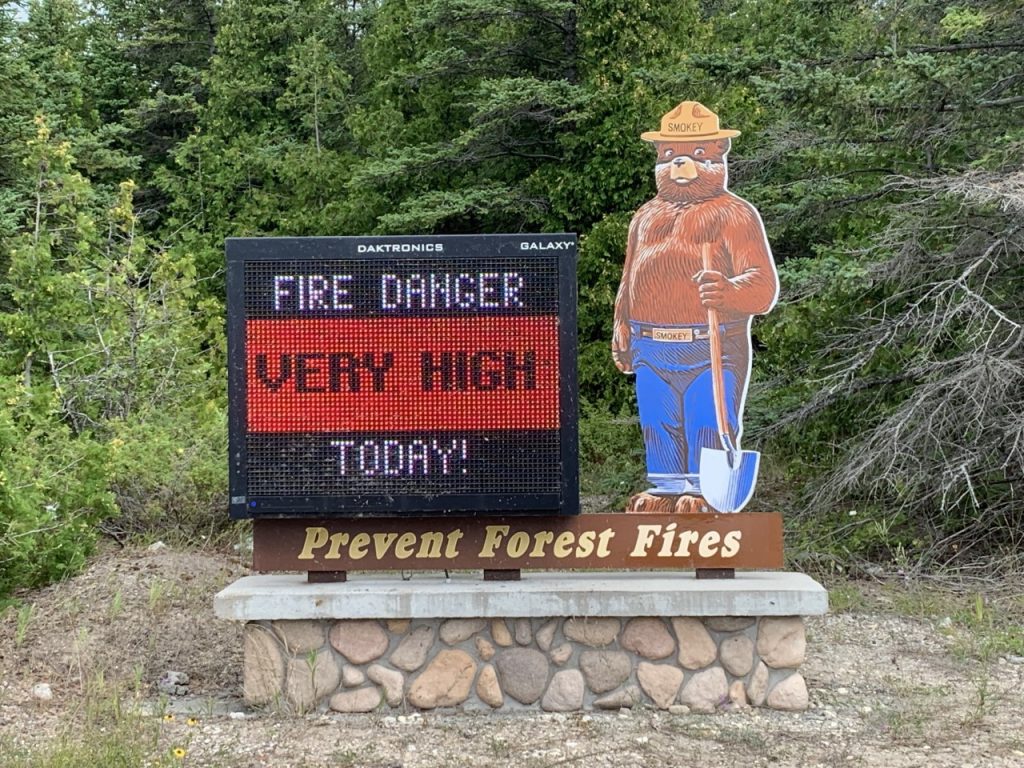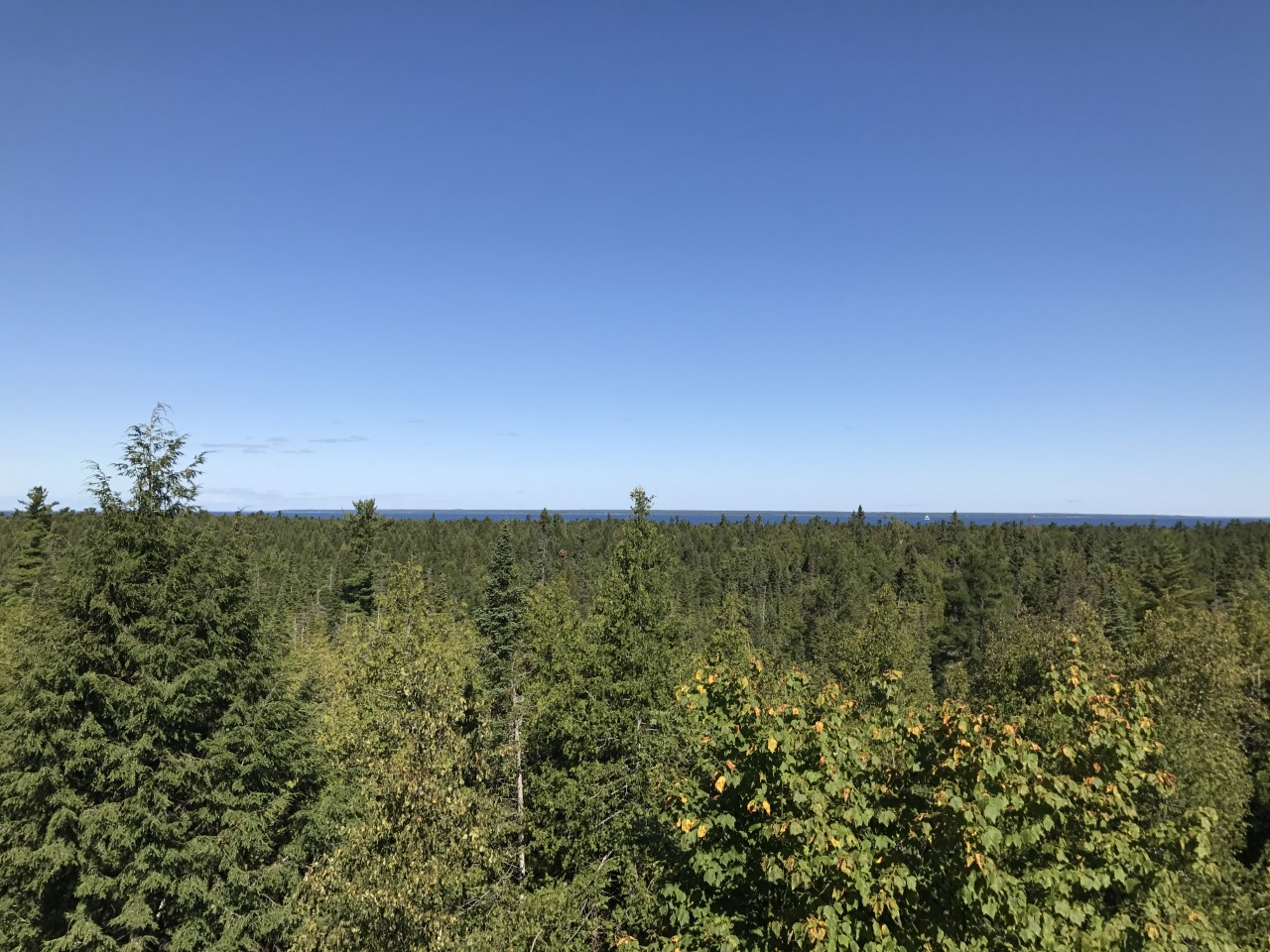Michigan Has Its Share of Wildfires, Caused Mostly by People
The DNR says it’s up to humans to prevent wildfires.

Wildfires have killed more than 100 people and destroyed thousands of homes in California since 2017. Cal Fire, the state’s forestry department, estimates almost 200,000 acres have burned so far this year, fueled by drought, high winds and too much dry vegetation.
California has about 33 million acres of forested land. That’s almost twice as much as Michigan has. The Michigan Department of Natural Resources manages about four million acres and responds to an average of 400 fires per year.
Dan Laux is the DNR’s fire supervisor. He says most wildfires are caused by people.
“Whether it be from debris burning, fire escaping from burn barrels on windy days, campfires left unattended, or power lines that may come down in a windstorm,” Laux says.

Lightning strikes can also spark wildfires.
The DNR doesn’t fight every wildfire in Michigan. Laux says local fire departments tend to handle fires in privately-owned woods. When it does get the call, he says the state’s primary job is to stop a fire from spreading.
“Our primary method of keeping it from spreading is to establish some form of a control line,” Laux says. “That could be using existing fire breaks such as a road, river or lake.”
The DNR has bulldozers with specially-designed plows to create those control lines. Laux says another challenge is clearing the ground of leaves, dry grass, and other natural materials that fuel wildfires.
“Stay with a fire at all times.” — Dan Laux, DNR fire supervisor.
Cal Fire says climate change has made the Golden State’s wildfires worse. While Michigan is susceptible to both climate change and fire, Laux says conditions here are different.
“They (California) are much hotter and drier throughout the year,” Laux says. “With the Great Lakes, Michigan sees a fair amount of moisture in the form of rain and higher humidity.” Laux says cooler springs have also reduced the average number of fires the DNR has handled over the last four or five years.
Since human activity is the leading cause of wildfires, Laux says it’s up to people to keep them from starting.
“The biggest role people have is to make sure that they’re not doing any open burning without a permit,” Laux says. “Stay with the fire at all times. And keep the right tools on hand, so that if you do run into a problem, you’re able to address that problem right away and before it gets too big and out of control.”
Fire Safety: Tips to Prevent Wildfires
Click on the player above to hear Dan Laux’s conversation with WDET’s Pat Batcheller, and read a transcript, edited for clarity, below.
Pat Batcheller, 101.9 FM, WDET: What are the most common causes of wildfires?
Dan Laux, Michigan DNR: The most common cause is human activity, whether it be from debris burning, fire escaping from burn barrels on windy days, campfires left unattended, power lines that may come down in a windstorm. We do get some lightning strikes as well. Those are typically later in the summer.
When are they most common?
In Michigan, our fire season starts in the spring when we lose our last snow pack and before the grasses and other fuels start to green up. Everything is still pretty much dried up and brown. That’s when it’s most susceptible to burning. That usually runs through the end of May on average statewide.

When the DNR is called in to help fight a wildfire, how do you contain it and keep it from spreading?
Our primary method of keeping it from spreading is to establish some form of a control line. That could be using existing fire breaks such as a road, river or lake. We fight fire quite mechanically. We have bulldozers with specially-designed fire plows on the back that allow the operator to go along the perimeter of the fire and put the plow down. That exposes the mineral soil to help keep it in check.
You mentioned fuel on the ground that feed wildfires. Do you have to keep a pretty good lid on that?
Yes. With most fires, that’s the primary carrier — ground fuels such as grass, leaves, stuff that’s down low. If you get an extreme fire, and you’ve got the right kind of winds, you can get into a situation where that fire gets up into the tree canopy. We’re talking mostly about pine-type fuels. Then it’ll turn into what’s considered a “crown fire,” which is actually a fire burning at the tops of the trees, from one tree to another, and it advances that way. When that happens, those are pretty hard to stop. You pretty much have to wait for them to hit a break in the fuel so they drop back down to the ground, where suppression action can be taken or air resources need to be utilized. You’re not going to stop them when it’s burning 30 or 40 feet above your head.
In 2008, there was a wildfire near Grayling that actually came pretty close to the edge of the city. You can see a lot of burn scars on trees when you drive through the area. How did that fire start, and how were you able to keep it from damaging businesses?
That particular fire was started by a railroad car. The fire jumped the expressway (I-75) and approached the Grayling area. I think the biggest thing that helped with that fire was, as it started getting closer to town, it was getting into the evening hours. Temperatures started to moderate and the fire conditions started to moderate a bit. The intensity died down a bit, which allowed crews to get on that fire more directly and getting that containment line put in to prevent it from spreading into the downtown area.
What’s the difference between wildfires in Michigan and California?
I think the biggest contributing factor is the difference in the weather. They (California) are much hotter and drier through the better portion of a year. With the Great Lakes, Michigan sees a fair amount of moisture in the form of rain and higher humidity. It’s not at all uncommon in the western states to have humidity in the teens for days and days, where we just don’t see that type of weather pattern here in Michigan. There are also different fuel types. We have some volatile fuels, such as jack pine. But a good portion of our forest land consists of a mix of northern hardwoods and conifers. Leafy hardwood trees are not as susceptible to fire as pines are.
Smokey Bear says, “only you can prevent wildfires.” So how do we do that?
The biggest role people have is to make sure that they’re not doing any open burning without a permit. Make sure the day they want to burn has the right weather for it. Stay with the fire at all times. So many wildfires we end up responding to, people go into the house for lunch or something when a wind gust comes up and spreads the fire. If they’d been right there, they could have prevented it from spreading. And keep the right tools on hand, so that if you do run into a problem, you’re able to address that problem right away and before it gets too big and out of control.
